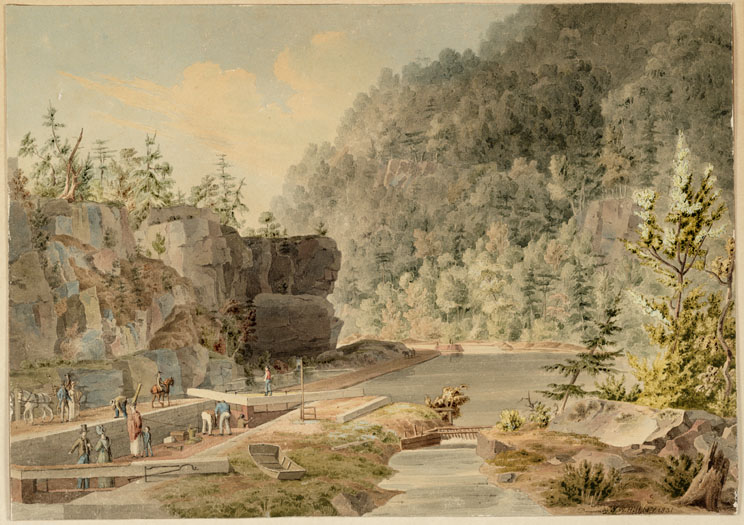
Between 1829 and 1831, Hill executed a number of watercolor views of the Erie Canal intended as studies for a portfolio of aquatints depicting scenes along the newly built canal. Although several plates were engraved, the series was never completed. This painting of the Erie Canal at Profile Rock near Little Falls, NY depicts the original canal, with a single lock. After the enlargement, begun in 1836, the canal was widened and the single lock was replaced with double locks.

The falls at Little Falls was so named to differentiate them from the Great Falls at Cohoes which was formed by the flow of the Mohawk to the Hudson. Both falls were formed during the Taconic Orogeny (mountain building period) which resulted from an Island Arc collision with Proto-North America about 460 million years ago. This is similar to the current westward movement of Japan's Island Arc system which will slowly, but eventually, collide with eastern Asia. Frequent earthquakes in eastern New York State during that time resulted in breaks and movement (faults) in huge blocks of rock. In various areas of the Mohawk Valley, some blocks were pushed up and some dropped down. As the ancient Mohawk River flowed eastward across the rising blocks, a channel was gradually cut. Because of the difference in elevation of the blocks and the difference in erosion rate of the more readily eroded softer rocks (Little Falls dolomite) compared to the harder (gneiss), the narrow channel that forms the falls at Little Falls was formed.
"A short distance below ... you pass a remarkable rock called the Nose. The mountains here are high like the Highlands of the Hudson on a small scale. The river must have burst a passage for itself ... the rocks are composed of granite and limestone -- the mountains are very steep" -- From the 1810 Canal Journal of DeWitt Clinton.
These formations created significant challenges for the canal builders. To bypass Little Falls, the Western Inland Navigation Company in 1793 began building a one mile canal with five wooden locks to surmount the 40 ft. high falls. In1802, the wooden locks were replaced with stone. Another path for the Erie Canal was constructed for the diversion channel and lift locks. The first and subsequent enlargements of the canal were even more challenging but did improve the flow of traffic. Currently, the Barge Canal at Little Falls has a single very high, 40 ft. lift lock.
The following is an excerpt from the Diary of Jonathan Pearson:
Grand Erie Canal Thursday July 25, 1833
"This part of the Canal was very expensive and difficult because for nearly two miles it was
made by blasting a hard flinty rock from the precipice on the one hand and building a wall from
20 to 30 ft. high on the other. Here are five [locks] within a mile and across the river is built a
beautiful aqueduct leading to a basin from which all the goods of the village are landed. This
aqueduct is built in the most durable manner on three arches, one main arch and two smaller, but
of how long a spring, I know not. The limestone of which it is built is very fine cut and
cemented in the most compact manner. It is really a beautiful work, uniting the conveniences of
art with the taste of architecture."
http://www.eriecanal.org/UnionCollege/175th-add.html